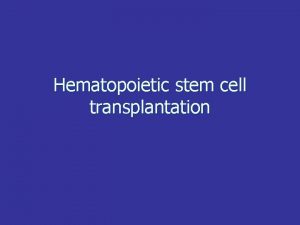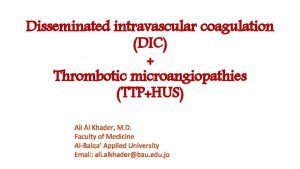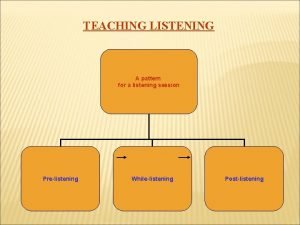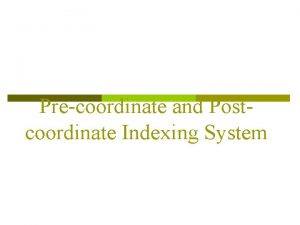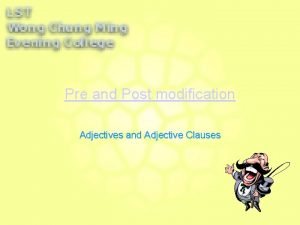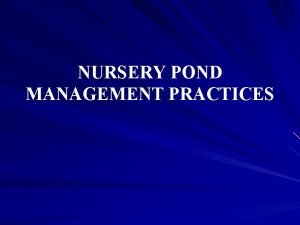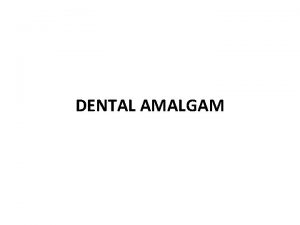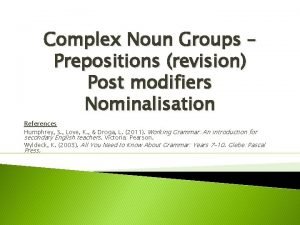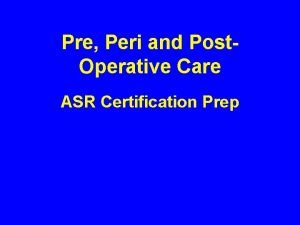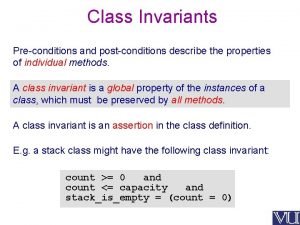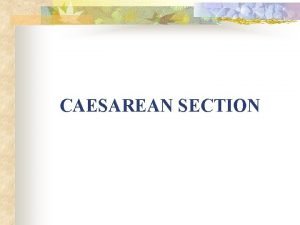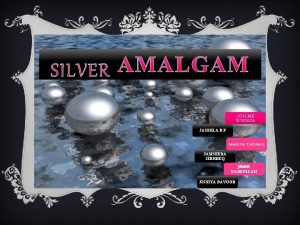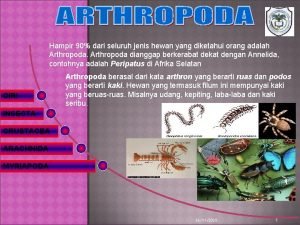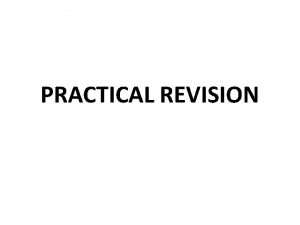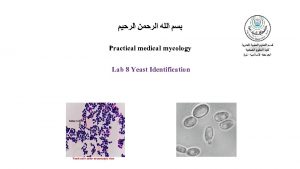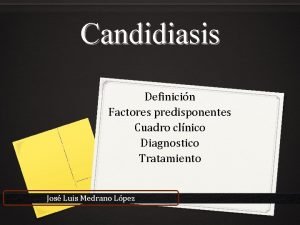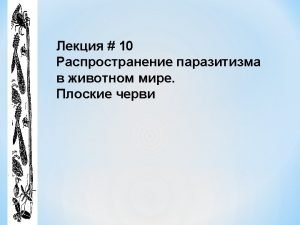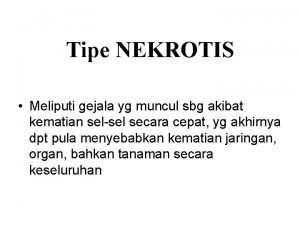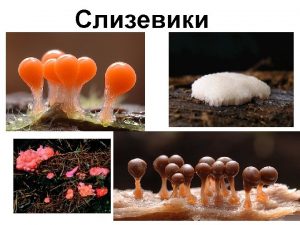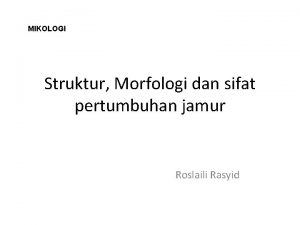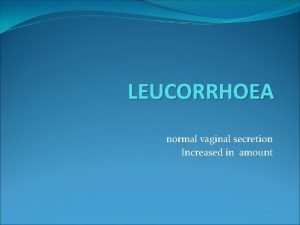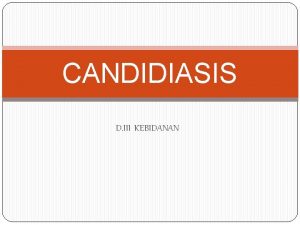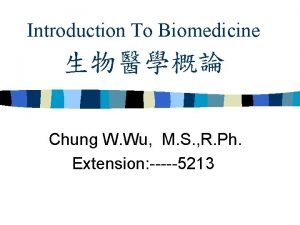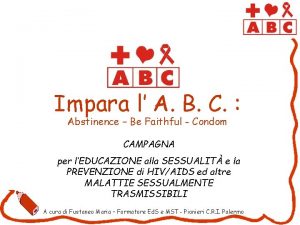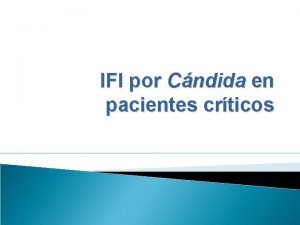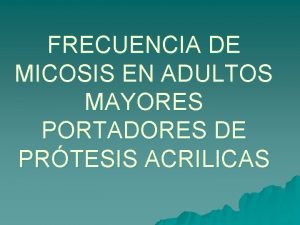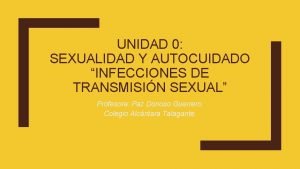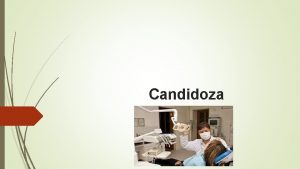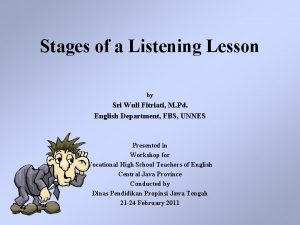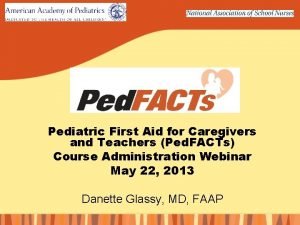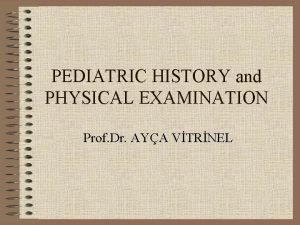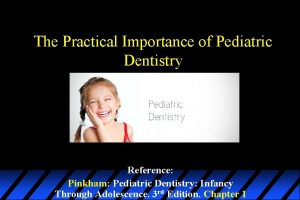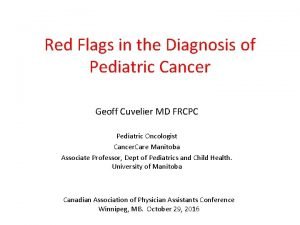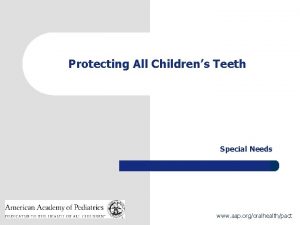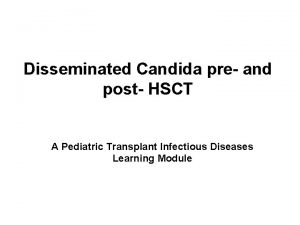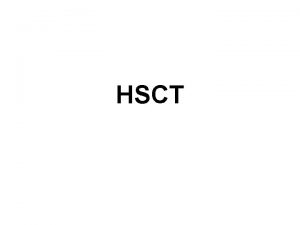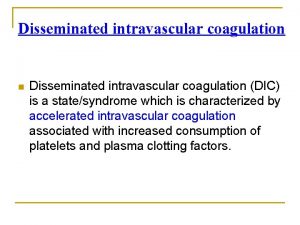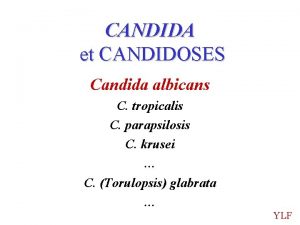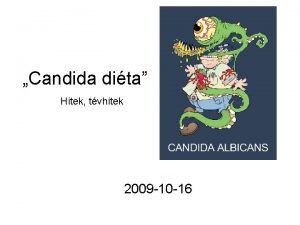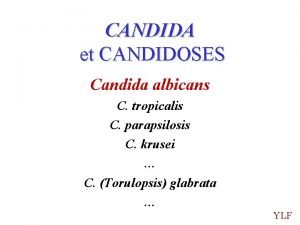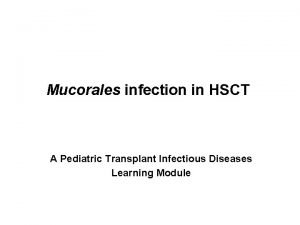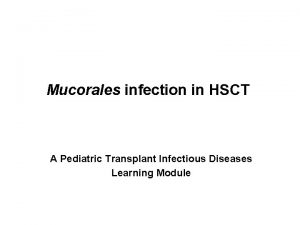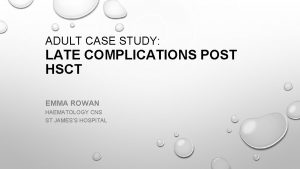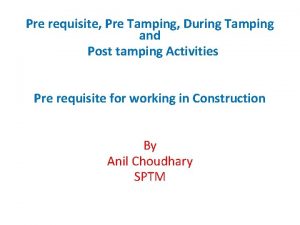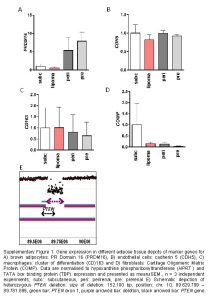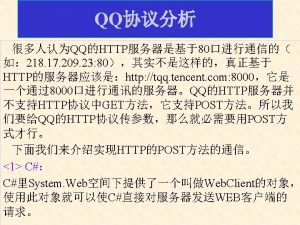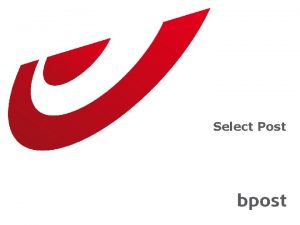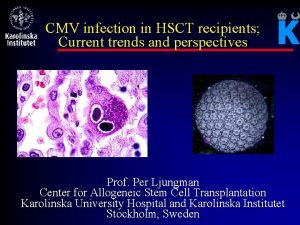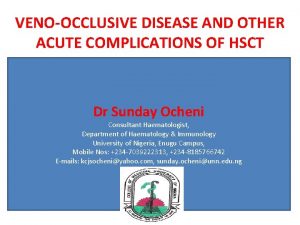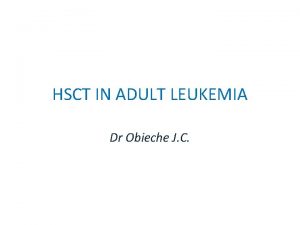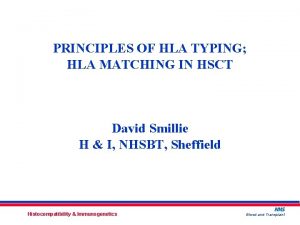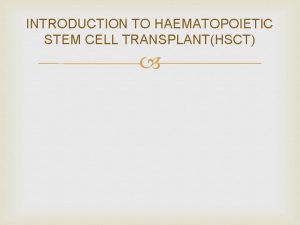Disseminated Candida pre and post HSCT A Pediatric






















































- Slides: 54

Disseminated Candida pre- and post- HSCT A Pediatric Transplant Infectious Diseases Learning Module

Using the Modules l l l The modules are case-based, with decision points (branches) containing questions ¾ Many questions don’t have right or wrong answers ¾ Click on a response (e. g. a diagnostic test), and you will find out more about it Multiple “action buttons” help you navigate The basic modules are designed to take about 45 minutes to complete You might take longer, especially if you choose to investigate all of the informational links provided Take your time and enjoy!

Navigating the Modules l l l DO NOT use your keyboard arrows or mouse click to advance slides Only use the navigation buttons on each slide – these will keep you from getting lost ¾ If you do get lost, you can hit the “home” button any time to go back Unlabeled button types you might encounter: ¾ Previous slide ¾ Next slide ¾ First slide ¾ More information ¾ Return to decision choices

Case Presentation l 26 month old female Presented with fever, pallor, petechial rash, and pancytopenia was diagnosed with high-risk AML based on a complex karyotype. ¾ Remission was successfully achieved and she will shortly undergo matched-unrelated T cell depleted HSCT with bone marrow as the cellular source. ¾

Case Presentation l 26 month old female ¾ She had three episodes of fever and neutropenia during her initial chemotherapy for AML. Ø Two episodes were culture negative Ø Third was associated with Klebsiella pneumoniae bacteremia with two positive blood cultures on consecutive days that cleared without CVC removal Ø One episode with prolonged fever for which she received 10 days of empiric micafungin prior to resolution of fever and recovery from neutropenia (imaging and lab evaluation normal at that time).

Case Presentation l 26 month old female ¾ l During her periods of neutropenia with AML chemotherapy she received fluconazole prophylaxis (6 mg/kg/day). Her current vascular access is a port that was placed following AML diagnosis. Question ¾ What is the recommended antifungal prophylactic regimen for this patient? Ø Fluconacole Ø Echinocandin (Micafungin/Caspofungin) Ø Voriconazole Ø Posaconazole

Fluconazole in HSCT Antifungal Prophylaxis l l l Spectrum of action: ¾ Limited to Candida spp. , Cryptococcus neoformans, and endemic/dimorphic fungi “Fluconazole is the drug of choice for the prophylaxis of invasive candidiasis before engraftment in allogeneic HCT recipients, and may be started from the beginning or just after the end of the conditioning regimen (AI)” Fluconazole prophylaxis dosing ¾ 6 mg/kg/dose given once daily (maximum daily dose = 400 mg/day) Goodman LJ et al. N Engl J Med 1992; 326: 845– 851 Slavin MA et al. J Infect Dis 1995; 171: 1545 -52. Tomblyn M et al. Biol Blood Marrow Transplant 2009; 15: 1143 -1238.

Echinocandins in HSCT Antifungal Prophylaxis l l l Spectrum of action: ¾ fungicidal against Candida spp. , fungistatic against Aspergillus spp. Yeast prophylaxis ¾ “Micafungin is an alternative prophylactic agent, as 1 study has shown it to be comparable to fluconazole for preventing possible or documented fungal infection (BI)” Mold prophylaxis ¾ “One study has shown micafungin to be effective in preventing invasive fungal infections (including fever) when administered during neutropenia. . . but the incidence of invasive aspergillosis is low during the preengraftment phase, so anti-mold efficacy could only show a display of activity rather than efficacy (BI). Experience with other echinocandins (eg, caspofungin) demonstrates some efficacy (CII), but breakthrough mold infections during echinocandin prophylaxis have been reported. ” van Burik JA et al. Clin Infect Dis 2004; 39: 1407– 1416 Tomblyn M et al. Biol Blood Marrow Transplant 2009; 15: 1143 -1238.

Voriconazole in HSCT Antifungal Prophylaxis l l Spectrum of action: ¾ Candida, Aspergillus, Fusarium, endemic/dimorphic fungi, Malassezia spp, Scedosporium, dematiaceous molds (*not Mucormycosis*) Primary Literature (Wingard et al. 2010) ¾ Randomized controlled trial fluconazole vs. voriconazole prophylaxis in HSCT >2 yrs of age (8. 5% of subjects <18 yrs) ¾ No significant difference between drugs with regard to freedom from invasive fungal infection or fungal free survival ¾ Caveat: study performed in context of structured galactomannan-based ‘screening’ program Tomblyn M et al. Biol Blood Marrow Transplant 2009; 15: 1143 -1238. Wingard JR et al. Blood 2010; 116: 5111 -8.

Posaconazole in HSCT Antifungal Prophylaxis l l Spectrum of action: ¾ Mucormycosis, Candida, Aspergillus spp. , Fusarium, endemic/dimorphi fungi, Malassezia spp. , Scedosporium, dematiaceous molds Primary Literature (Ullman et al. 2007) ¾ Randomized controlled trial of posaconazole versus fluconazole in HSCT patients with GVHD on immunosuppression ¾ Trend toward decreased proven or probable invasive fungal infection in posaconazole versus fluconazole group (5. 3% vs. 9. 0%, p=0. 07) ¾ Significantly decreased invasive aspergillosis in posaconazole versus fluconazole group (2. 3% vs. 7. 0%, p=0. 006) Tomblyn M et al. Biol Blood Marrow Transplant 2009; 15: 1143 -1238. Ullmann AJ et al. N Engl J Med 2007; 356: 335 -347

Case Presentation: Hospital Course l l The patient undergoes preparative regimen followed by stem cell infusion and receives fluconazole prophylaxis. On the third day (d+3) after cell infusion she develops fever (ANC 0). She has no evidence of hemodynamic compromise. Exam: ¾ Her port site shows no erythema or induration and she has no localizing symptoms or signs. Evaluation: ¾ Peripheral and central blood cultures are obtained ¾ She is started on Cefepime and remains on fluconazole. ¾ Initial blood cultures are negative and daily blood cultures are obtained.

What is your differential diagnosis for fever and neutropenia in a pediatric HSCT patient early post-HSCT? l l l Bacterial bloodstream infection Respiratory viral infection CMV syndrome/infection Mold infection/invasive aspergillosis Invasive candidiasis

Bacterial bloodstream infection in pediatric HSCT recipients l l Potential cause of infection early post-transplant Can cause fever without localizing signs Highest risk period is preengraftment List of potential bacterial etiologies depends on antecedent infection history, antibiotic therapy, and antibiotic prophylaxis if used Gram-positive bacteria Staphylococcus aureus Coagulase-negative staphyloccci Viridans streptococci Enterococcus faecium/faecalis Streptococcus pneumoniae Streptococcus pyogenes Gram-negative bacteria Escherichia coli Klebsiella pneumoniae Enterobacter spp Pseudomonas aeruginosa Citrobacter spp Stenotrophomonas maltophilia

Respiratory viral infection in pediatric HSCT recipients l l l Usually associated with respiratory symptoms May be acquired pre-transplant and lead to disease post-transplant Etiologies ¾ Influenza ¾ RSV ¾ Metapneumovirus ¾ Parainfluenza ¾ Adenovirus ¾ Rhinovirus

CMV syndrome/infection in pediatric HSCT recipients l l l CMV viremia is often asymptomatic and detected by screening at regular intervals post-transplant Preemptive or prophylactic approaches are used for CMV prevention in pediatric HSCT recipients In one pediatric study (Rowe et al. 2016) median onset of CMV infection was 46 days after graft infusion (range 9 -127 days) Rowe RG et al. Biol Blood Marrow Transplant 2016; S 1083 -8791

Mold infection in pediatric HSCT recipients l l Invasive mold infection (primarily Aspergillus spp. ) in HSCT recipients has a biphasic peak with an early peak corresponding to the pre-engraftment phase (030 days) and a later peak corresponding to onset of GVHD and GVHD related immunosuppression. Etiologies ¾ Aspergillus spp. ¾ Murcorales ¾ Fusarium ¾ Scedosporium

Invasive Candidiasis in pediatric HSCT recipients l l Invasive candidiasis usually occurs in the neutropenic, pre-engraftment period post-HSCT Origin of invasive candidiasis is usually from endogenous colonization of gastrointestinal tract. Post-transplant antifungal prophylaxis decreases frequency of invasive candidiasis Fluconazole-resistant Candida isolates exist and are increasing in frequency

Case Presentation: Hospital Course l l On day +7 she remains febrile with ANC of 0. The microbiology lab calls and reports that the port blood culture from day d+6 is growing yeast, probable Candida species. What recommendation for antifungal therapy and what dosing do you make? ¾ Fluconazole ¾ Echinocandin

Fluconazole is NOT first line treatment for Candidemia in the neutropenic patient l l l Echinocandins are recommended as initial therapy for candidemia in neutropenic patients (strong recommendation, moderate quality evidence) Fluconazole is an alternative if the patient is not critically ill and has no prior azole exposure (weak recommendation; low-quality evidence) “Fluconazole can be used for step-down therapy during persistent neutropenia in clinically stable patients who have susceptible isolates and documented bloodstream clearance (weak recommendation; low-quality evidence). ” ¾ Dosing fluconazole for candidemia in appropriate setting Ø 12 mg/kg (max 800 mg) loading dose, then 6 mg/kg (max 400 mg) daily Ø Some pediatric experts recommending higher loading and treatment doses (up to 25 mg/kg for loading dose and up to 12 mg/kg/day for treatment dose) Pappas PG et al. Clin Infect Dis 2016; 62: e 1 -e 50

Echinocandins ARE the recommended initial therapy for Candidemia in neutropenic patients l l l Echinocandins are recommended as initial therapy in for Candidemia in neutropenic patients (strong recommendation, moderate quality evidence) Fluconazole is an alternative if the patient is not critically ill and has no prior azole exposure (weak recommendation; low-quality evidence) Echinocandin dosing for Candidemia ¾ Micafungin Ø 2 mg/kg/dose once daily (max dose 100 mg daily) ¾ Caspofungin 2 2 Ø 70 mg/m /dose on day 1 followed by 50 mg/m /dose once daily *Check appropriate updated dosing recommendations. Higher doses can be used in setting of esophageal candidiasis and treatment-refractory Candidemia

Case Presentation: Hospital Course l l The patient is started on Micafungin while awaiting further identification and susceptibility results. What recommendation do you make regarding line salvage versus line removal? ¾ Treat with port in place ¾ Remove port and treat through peripheral IV

Central Line Removal for Candidemia (1 of 3): Guideline Recommendations l IDSA recommendations ¾ “Central venous catheters (CVCs) should be removed as early as possible in the course of candidemia when the source is presumed to be the CVC and the catheter can be removed safely; this decision should be individualized for each patient (strong recommendation; moderate-quality evidence). ” ¾ “In the neutropenic patient, sources of candidiasis other than a CVC (eg, gastrointestinal tract) predominate. Catheter removal should be considered on an individual basis (strong recommendation; low-quality evidence). ” Pappas PG et al. Clin Infect Dis 2016; 62: e 1 -e 50

Central Line Removal for Candidemia (2 of 3): Primary Literature Retrospective cohort study of pediatric patients with candidemia Primary outcome: 30 -day all cause inpatient mortality l l N=285 patients with Candidemia and CVC in place Patient characteristics at time of blood culture ¾ Median age: 2 years Ø ¾ ¾ ¾ l l IQR: 0. 7 -11. 6 yrs ICU admission – 42% Dialysis – 2. 8% Receipt of TPN – 63. 9% Immunosuppression – 20. 3% Surgery in prior 2 weeks – 26. 3% Overall mortality – 10. 5% CVC retention was significantly associated with 30 -day all cause inpatient mortality Discrete time-failure model ¾ Adjusted for age and complexity of clinical care ¾ OR 2. 50; 95% CI, 1. 06– 5. 91 ¾ l Limitations included unmeasured confounders related to severity of illness Fisher BT et al. J Pediatric Infect Dis Soc 2015, Aug 16 [Epub ahead of print]

Central Line Removal for Candidemia (3 of 3): Primary Literature Patient level quantitative review of randomized Candidemia treatment trials Primary outcome: 30 day all-cause mortality l Patient characteristics ¾ ¾ ¾ Mean patient age: 55. 1 years 78% with central venous catheters 4. 8% with transplantation 28. 6% on immunosuppressive therapy 84. 8% with bloodstream infection Overall 30 day mortality – 31. 4% Andes DR et al. Clin Infect Dis 2012; 54: 1110 -22 l CVC removal during treatment associated with improved survival CVC removal, 28% 30 -day mortality ¾ CVC retention, 41% 30 -day mortality ¾ Candidemia subgroup ¾ Ø Ø OR for 30 day mortality with CVC removal OR 0. 45; 95% CI 0. 310. 67, p=0. 0001

Case Presentation: Hospital Course l l l The port is removed, but given concerns regarding access and need for ongoing parenteral nutrition, a PICC was placed concurrently with line removal. Daily blood cultures are obtained and on day +9 she remains febrile and has positive blood cultures for yeast on days +6, +7, and +8. The isolate from day +6 has been identified as Candida glabrata and is fluconazole resistant. What recommendation do you make regarding treatment of Candida glabrata in this patient? ¾ Continue treatment with echinocandin ¾ Change treatment to Lipid-formulation Amphotericin B

Epidemiology of Invasive Candida Infection l Speciation for pediatric invasive Candidiasis Candida species # (total =449) % C. albicans 180 40% C. parapsilosis 100 22% Other Candida spp. 62 14% C. glabrata 40 9% C. lusitaniae 24 5% C. krusei 16 4% Unknown Candida species 11 2% C. guilliermondii 9 2% C. dubliniensis 7 2% Steinbach WJ et al. Pediatr Infect Dis J 2012; 31: 1252 -7 Palazzi D et al. Pediatr Infect Dis J 2014; 33: 1294 -6

Epidemiology of Antifungal Resistance in Candida General resistance patterns by Candida species C. albicans Ø generally susceptible ¾ C. parapsilosis Ø Occasional echinocandin resistance Ø Controversy regarding poorer outcomes with echinocandin treatment ¾ C. tropicalis Ø Rarely fluco-R ¾ C. glabrata Ø Frequently fluco-R Ø Rising echinocandin-R Ø Rare Ampho B-R ¾ C. krusei Ø Frequent fluco-R Ø Rare Ampho. B - R ¾

Epidemiology of Antifungal Resistance in Candida l l Increasing frequency of concurrent resistance against fluconazole and echinocandins is reported in C. glabrata isolates. Candida glabrata resistance in two large surveillance programs (Pfaller et al. 2012) ¾ ¾ ¾ SENTRY Antimicrobial surveillance program AND CDC populationbased surveillance 2006 – 2010 9. 7% isolates resistant to fluconazole 11. 1% of fluconazole-resistant isolates also resistant to ≥ 1 echinocandin Prior surveillance (2001 -2004) indicated no echinocandin resistant C. glabrata strains among those with fluconazole resistance Pfaller MA et al. J Clin Microbiol 2012; 50: 1199 -1203 Alexander BD et al. Clin Infect Dis 2013; 56: 1724 -32. .

Epidemiology of Antifungal Resistance in Candida l l Increasing frequency of concurrent resistance against fluconazole and echinocandins is reported in C. glabrata isolates. Single-center retrospective review of C. glabrata bloostream isolates (n=313) from 2001 – 2010 (Alexander et al. 2013) Echinocandin resistance increased from 4. 9% to 12. 3% of isolates across study period ¾ Fluconazole resistance increased from 18% to 30% of isolates across study period ¾ Pfaller MA et al. J Clin Microbiol 2012; 50: 1199 -1203 Alexander BD et al. Clin Infect Dis 2013; 56: 1724 -32. .

Case Presentation: Hospital Course l Based on persistent positive cultures while undergoing treatment with micafungin and her prior exposure to micafungin during her pretransplant course, you are concerned that her C. glabrata isolate has both fluconazole and echinocandin resistance. You initiate treatment with liposomal Amphotericin B.

Case Presentation: Hospital Course l l C. glabrata susceptibility testing returns with fluconazole resistance and echinocandin susceptibility. You choose to treat with micafungin. What recommendation do you make regarding further management and evaluation for infection source in this patient? ¾ Echocardiogram ¾ Abdominal US ¾ Chest CT ¾ Eye exam ¾ PICC removal

Disseminated Candidiasis l l l Definition: Disease caused by tissue invasive Candida infection Frequency: 8. 3 – 17% of children with candidemia have evidence of dissemination Relative frequency of anatomic dissemination sites ¾ Lungs > Liver > Kidney > Heart > Spleen > Eyes Zaoutis TE et al. Pediatr Infect Dis J 2004; 23: 635 -641 Chapter 198 Feigin and Cherry’s Textbook of Pediatric Infectious Diseases, 7 th ed. 2014

Endovascular Candidiasis l l l Infective endocarditis is the most common form ¾ Pathogenesis is potentially related to endothelial trauma secondary to central venous catheters resulting in endocarditis Septic thrombophlebitis and mycotic aneurysm also occur Pericarditis and myocarditis are rare Millar BC et al. Pediatr Cardiol 2005; 26: 517 -536 500 X GMS stain of human heart tissue showing Candidal yeast forms and pseudohyphae Accessed at http: //phil. cdc. gov

Abdominal Candidiasis l l l Occurs in the setting of active/ongoing candidemia or after a previously asymptomatic seeding event (Hepatosplenic Candidiasis) Kidney ¾ Renal abscess ¾ Renal mycetoma (fungal ball) Liver or splenic abscesses

Hepatosplenic Candidiasis l l l Pathophysiology is thought to be asymptomatic dissemination during neutropenic period followed by persistent fever during neutrophil recovery Liver and spleen primarily affected but can also involve other organs Diagnosis ¾ Blood culture low yield ¾ Lesions detectable by US and/or CT with neutrophil recovery ¾ Lesions may resolve with neutropenia despite continued presence of Candida in tissue and continued need for antifungal treatment Computed tomography of abdomen in patient with hepatosplenic Candidiasis. Images show multiple low attenuation lesions in the hepatic (arrows) and renal (arrowheads) parenchyma. Photo courtesy of Daniel Dulek

Pulmonary Candidiasis l l Three forms ¾ Primary bronchopneumonia = rare ¾ Secondary to hematogenous dissemination during Candidemia ¾ Secondary to septic thromboemboli Diagnosis requires histopathologic evidence of Candida invading lung tissue BAL detection of Candida ≠ diagnostic for invasive disease Chest imaging is not needed in every case of potential invasive Candidiasis unless it provides additional diagnostic information. Chapter 198 Feigin and Cherry’s Textbook of Pediatric Infectious Diseases, 7 th ed. 2014 Pappas PG et al. Clin Infect Dis 2016; 62: e 1 -e 50

Ocular Candidiasis l l l Manifests as ¾ Endophthalmitis ¾ Chorioretinitis ¾ Vitritis Frequency of occurrence ranges from 2 -19% Pediatric study ¾ 8 out of 254 patients (2. 9%) with Candidemia and dilated retinal exam had abnormality attributable to Candidal infection (Fierro et al. 2013) Ø Not limited to HSCT patients Fierro JL et al. Pediatr Infect Dis J 2013; 32: 84– 6. Retinal photograph of a patient with C. tropicalis chorioretinitis in the setting of multifocal disseminated invasive Candidiasis. Photo courtesy of Daniel Dulek

Eye Exam Recommendation -- IDSA l “All patients with candidemia should have a dilated retinal examination, preferably performed by an ophthalmologist, within the first week of therapy in nonneutropenic patients to establish if endophthalmitis is present (strong recommendation; lowquality evidence). For neutropenic patients, it is recommended to delay the examination until neutrophil recovery (strong recommendation; low-quality evidence). ” Pappas PG et al. Clin Infect Dis 2016; 62: e 1 -e 50

Case Presentation: Hospital Course l l l On day +9 you request and obtain an echocardiogram, abdominal ultrasound, and ophthalmology exam for the patient. The PICC is removed antifungal therapy (micafungin) is administered by PIV. Echocardiogram, US, and eye exam are normal. Two days (day +11) after PICC removal, fever resolves, blood culture from day +9 is positive for yeast but day +10 is negative.

Case Presentation: Hospital Course l l She is presently at day +14 with 3 negative blood cultures with at least 72 hours of growth. Her current ANC is 0 and HSCT team anticipates 710 more days of neutropenia

Case Presentation: Hospital Course l What treatment duration do you recommend for this patient? ¾ 2 weeks from bloodstream clearance irrespective of neutrophil recovery ¾ 2 weeks from bloodstream clearance as long as her ANC is >500 by treatment completion ¾ 2 weeks from bloodstream clearance with normalization of ANC and normal repeat eye exam and abdominal ultrasound

Invasive Candidiasis Treatment Duration (1 of 3) l Treatment duration: Candidemia in neutropenic patients ¾ “Recommended minimum duration of therapy for candidemia without metastatic complications is 2 weeks after documented clearance of Candida from the bloodstream, provided neutropenia and symptoms attributable to candidemia have resolved (strong recommendation; low-quality evidence). ” ¾ ”Ophthalmological findings of choroidal and vitreal infection are minimal until recovery from neutropenia; therefore, dilated funduscopic examinations should be performed within the first week after recovery from neutropenia (strong recommendation; low-quality evidence). ” Pappas PG et al. Clin Infect Dis 2016; 62: e 1 -e 50

Invasive Candidiasis Treatment Duration (2 of 3) Form of Disease Antifungal Duration Other weeks followed by step down to oral fluconazole immunosuppression Native valve endocarditis Lipid formulation Am. B with or without flucytosine OR highdose echinocandin as initial therapy Step down to fluconazole if isolate is susceptible, patient is clinically stable, and bloodstream has cleared. Tx should continue at least Valve replacement 6 weeks post-surgery or recommended. longer if perivalvular abscess Suppurative thrombophlebitis Lipid formulation Am. B or fluconazole or echinocandin At least two weeks after candidemia has resolved. Osteomyelitis Fluconazole x 6 -12 months with or without preceding 2 weeks of echinocandin 6 -12 months Treatment duration for other forms of invasive Initial therapy with lipid Until lesions on imaging resolve AND through Candidiasisformulation Am. B or echinocandin for several period of ongoing l Chronic disseminated (hepatosplenic) Candidiasis Pappas PG et al. Clin Infect Dis 2016; 62: e 1 -e 50 Catheter removal and incision/drainage or resection of the vein

Invasive Candidiasis Treatment Duration (3 of 3) Form of Disease Antifungal Duration Other Treatment duration for other forms of invasive Septic arthritis 6 weeks Removal of Candidiasis. Fluconazole for 6 weeks, OR l echinocandin for 2 weeks followed by at least 4 weeks of fluconazole Chorioretinitis with or without vitritis CNS Candidiasis prosthetic device recommended if present. If susceptible, fluconazole or voriconazole. If –azole resistant, liposomal Am. B with or without flucytosine. If macular involvement or vitritis, above PLUS intravitreal injection of Am. B deoxycholate or voriconazole At least 4 -6 weeks depending on resolution of lesions based on repeat ophthalmological exams Liposomal Am. B with or without flucytosine. Step down to fluconazole once patient has responded Treat until resolution of all CNS and/or radiologic abnormalities. UTI with fungus balls Oral fluconazole, OR Am. B deoxycholate with or without fluctyosine. Am. B deoxycholate irrigation through nephrostomy tubes if present Pappas PG et al. Clin Infect Dis 2016; 62: e 1 -e 50 Duration not clearly defined Consult ophthalmology If vitritis present, Vitrectomy should be considered Surgical resection recommended in adults

Case Presentation: Conclusion l l The patient continues treatment with micafungin continued through day +24 with neutrophil engraftment having occurred on day +22 (total treatment duration = 14 days) Repeat dilated retinal exam by ophthalmology as well as abdominal ultrasound on day +21 were normal

Summary l l l Invasive candidiasis infection can occur in pediatric HSCT recipients despite antifungal prophylaxis Frequency of fluconazole and echinocandin resistance may be increasing and is of particular concern with isolates of C. glabrata and C. krusei Evaluation for localized sites of dissemination (Eyes, Heart, Liver, Kidneys, Spleen) is critical in the setting of fungemia Manifestations of disseminated candidiasis may be delayed until after neutrophil recovery Central line removal, if feasible, is a critical feature of the management of candidemia

References: Guidelines Hope WW et al. ESCMID guideline for the diagnosis and management of Candida diseases 2012: prevention and management of invasive infections in neonates and children caused by Candida spp. Clin Microbiol Infect 2012; 18: 3852. ¾ Science M et al. Guideline for primary antifungal prophylaxis for pediatric patients with cancer or hematopoietic stem cell transplant recipients. Pediatr Blood Cancer 2014; 61: 393400. ¾ Tomblyn M et al. Guidelines for preventing infectious complications among hematopoietic cell transplantation recipients: a global perspective. Biol Blood Marrow Transplant 2009; 15: 1143 -1238. ¾ Pappas PG et al. Clinical Practice Guideline for the Management of Candidiasis: 2016 Update by the Infectious Diseases Society of America. Clin Infect Dis 2016; 62: e 1 e 50. ¾

References: Primary Literature l Pediatric Epidemiology Steinbach WJ et al. Results from a Prospective, International, Epidemiologic Study of Invasive Candidiasis in Children and Neonates. Pediatr Infect Dis J 2012; 31: 1252 -57. ¾ Prasad PA et al. Pediatric Risk Factors for Candidemia Secondary to Candida glabrata and Candida krusei species. J Pediatric Infect Soc 2013; 2: 263 -6. ¾ Zaoutis TE et al. Risk factors for disseminated candidiasis in children with candidemia. Pediatr Infect Dis J 2004; 23: 635 -41. ¾ Festekjian A et al. Incidence and Predictors of Invasive Candidiasis Associated with Candidemia in Children. Mycoses 2011; 54: 146 -153. ¾

References: Primary Literature l Treatment/Resistance ¾ ¾ ¾ Mora-Duarte J et al. Comparison of caspofungin and amphotericin B for invasive candidiasis. N Engl J Med 2002; 347: 2020 -9. Betts R et al. Efficacy of caspofungin against invasive Candida or invasive Aspergillus infections in neutropenic patients. Cancer 2006; 106: 466 -73 Kuse ER et al. Micafungin versus liposomal amphotericin B for candidemia and invasive candidosis: a phase III randomized double-blind trial. Lancet 2007; 369: 1519 -27. Alexander BD et al. Increasing echinocandin resistance in Candida glabrata: clinical failure correlates with presence of FKS mutations and elevated minimum inhibitory concentrations. Clin Infect Dis 2013; 56: 1724 -32. Kanji JV et al. Treatment of invasive candidiasis in neutropenic patients: systematic review of randomized controlled treatment trials. Leuk Lymphoma 2013; 54: 1479 -87 Fernandez-Ruiz M et al. Initial use of echinocandins does not negatively influence outcome in Candida parapsilosis bloodstream infection: a propensity score analysis. Clin Infect Dis 2014; 58: 1413 -21.

References: Primary Literature l Prophylaxis Slavin MA et al. Efficacy and safety of fluconazole prophylaxis for fungal infections after marrow transplantation—a prospective, randomized, double-blind study. J Infect Dis 1995; 171: 1545 -52. ¾ Goodman JL et al. A controlled trial of fluconazole to prevent fungal infections in patients undergoing bone marrow transplantation. N Engl J Med 1992; 326: 845– 851 ¾ Wingard JR et al. Randomized, double-blind trial of fluconazole versus voriconazole for prevention of invasive fungal infection after allogeneic hematopoietic cell transplantation. Blood 2010; 116: 5111 -8. ¾ Ullmann AJ, Lipton JH, Vesole DH, et al. Posaconazole or fluconazole for prophylaxis in severe graft-versus-host disease. N Engl J Med 2007; 356: 335 -347 ¾ l Evaluation for dissemination ¾ Fierro JL, Prasad PA, Fisher BT, et al. Ocular manifestations of candidemia in children. Pediatr Infect Dis J 2013; 32: 84– 6.

References: Primary Literature l Line removal Andes DR et al. Impact of treatment strategy on outcomes in patients with candidemia and other forms of invasive candidiasis: a patient-level quantitative review of clinical trials. Clin Infect Dis 2012; 54: 1110 -22. ¾ Garnacho-Montero J et al. Impact on hospital mortality of catheter removal and adequate antifungal therapy in Candida spp. Bloodstream infections. J Antimicrob Chemother 2013; 68: 206 -13 ¾ Fisher BT et al. Central Venous Catheter Retention and Mortality in Children with Candidemia: A Retrospective Cohort Analysis. J Pediatric Infect Dis Soc 2015; ¾

Location Links within Slide Set l l l Candida epidemiology and resistance Disseminated Candida infection Treatment of invasive Candidiasis

This module was developed by: l Daniel E Dulek, MD, Vanderbilt University School of Medicine l William J Steinbach, MD, Duke University School of Medicine Original Version Date: 3/15/2016 Revised on: Part of an educational effort through the PIDS Transplant Infectious Disease working group and the AST ID Community of Practice

Feedback on the Modules l l l PLEASE help to provide us with feedback on the content of these modules! Let us know what you learned and what we can do better Your feedback will help us to improve this work and design future modules l l For any questions or concerns, please contact Tanvi Sharma tanvi. sharma@childrens. harvard. edu
 Two node loop instability
Two node loop instability Disseminated intravascular coagulation pathophysiology
Disseminated intravascular coagulation pathophysiology Allo-hsct definition
Allo-hsct definition Dic labs
Dic labs Khrihfa hlabu 323
Khrihfa hlabu 323 What is post listening stage
What is post listening stage Post coordinate indexing
Post coordinate indexing Pre and post modification
Pre and post modification Preparation and management of nursery pond
Preparation and management of nursery pond Advantages of eames technique
Advantages of eames technique Examples of noun groups
Examples of noun groups Preoperative nursing care for eye surgery
Preoperative nursing care for eye surgery Pre- post- peri-
Pre- post- peri- Class invariants
Class invariants Pre and post operative care for cesarean section ppt
Pre and post operative care for cesarean section ppt Pre carve and post carve burnishing
Pre carve and post carve burnishing Pre reading while reading and post reading activities
Pre reading while reading and post reading activities Sistem peredaran darah chilopoda
Sistem peredaran darah chilopoda Cryptococcus neoformans india ink
Cryptococcus neoformans india ink Mycology
Mycology Glosistis
Glosistis Bdelloura candida
Bdelloura candida Albugo candida
Albugo candida Plasmodiophoromycetes
Plasmodiophoromycetes Triangulo de killian
Triangulo de killian Kemotropik
Kemotropik Premenstrual discharge
Premenstrual discharge Ocular histoplasmosis triad
Ocular histoplasmosis triad Candida albicans
Candida albicans Perléche
Perléche Lact enz candida
Lact enz candida Candida albicans kingdom
Candida albicans kingdom Candida pseudotropicalis
Candida pseudotropicalis Candida intestinale sintomi
Candida intestinale sintomi Score candida
Score candida Ketoconasol crema
Ketoconasol crema Cándida albicans en hombres
Cándida albicans en hombres Genul candida
Genul candida Znacznik pre /pre jest stosowany w celu wyświetlenia
Znacznik pre /pre jest stosowany w celu wyświetlenia Kennisnetgeboortezorg
Kennisnetgeboortezorg Rafael sanguinetti
Rafael sanguinetti Cuidados pre y post quirurgicos
Cuidados pre y post quirurgicos Patch conforming method ansys
Patch conforming method ansys Pengertian pre production
Pengertian pre production Post millennial eschatology
Post millennial eschatology Pre or post tribulation
Pre or post tribulation Pre award vs post award
Pre award vs post award Stages of a listening lesson
Stages of a listening lesson Pediatric first aid for caregivers and teachers
Pediatric first aid for caregivers and teachers Pediatric history and physical examination
Pediatric history and physical examination Claire dees
Claire dees Miami pediatric nephrology seminar
Miami pediatric nephrology seminar Pediatric dentistry definition
Pediatric dentistry definition Headache red flags
Headache red flags Pediatric seizures
Pediatric seizures


